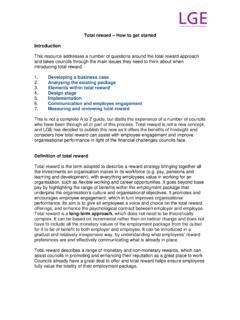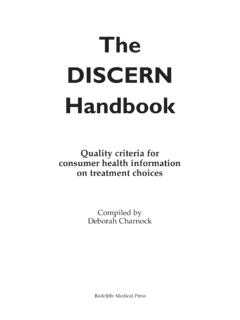Transcription of Low Carbon Transport: A Greener Future
1 Low Carbon transport : A Greener FutureA Carbon Reduction Strategy for transport July 2009 Department for TransportLow Carbon Transport: A Greener FutureA Carbon Reduction Strategy for TransportPresented to Parliament by the Secretary of State for Transportby command of Her MajestyJuly 2009Cm 7682 Crown Copyright 2009 The text in this document (excluding the Royal Arms and other departmental or agency logos) may be reproduced free of charge in any format or medium providing it is reproduced accurately and not used in a misleading material must be acknowledged as Crown copyright and the title of the document specified. Where we have identified any third party copyright material you will need to obtain permission from the copyright holders any other use of this material please write to Office of Public Sector Information, Information Policy Team, Kew, Richmond, Surrey TW9 4DU or e-mail: ContentsForeword 3 Executive summary 51.
2 Introduction 152. transport and climate change the need for action 173. Supporting a shift to new technologies and cleaner fuels 334. Promoting lower Carbon choices 615. Using market mechanisms to encourage a shift to lower Carbon transport 856. The impact of this strategy 937. How this strategy will work 103 Photographic acknowledgementsFront cover: all Alamy ImagesAECOM: / Alamy Images: , 39, 44, 58, 68, 85, 89, 93, 103, 104, 105 / Aviation Images Ltd: , 88 / buckinghamshire Country council : / Devon County council : / Eddie Stobart: / General Motors Corporation (Europe): / Highways Agency Image Library: , 14 / London and South Eastern Railway Ltd: , 52 / Low Carbon Vehicle Partnership: / Peterborough City council : / Trimedia International AG: strategy is intended to enable the UK to meet the requirements of the Carbon budgets set under the Climate Change Act 2008.
3 Implementation of the strategy will be taken forward in a way that recognises and respects the policy responsibilities and powers of the devolved administrations in Northern Ireland, Scotland and Wales regulation of aviation and air transport is reserved, as is the regulation of merchant shipping. With certain exceptions, such as safety, rail policy is a devolved matter in Scotland; the Welsh Assembly Government has powers in relation to Welsh and cross-border rail services. The provision of trunk roads and motorways in Northern Ireland, Scotland and Wales is devolved along with the management of their maintenance and certain exceptions road traffic regulation is largely reserved. Some parts of policy, such as road safety education are devolved matters for Northern Ireland, Scotland and Putting Britain on the path to a low Carbon Future is one of my key tasks as transport Secretary.
4 We all know that good transport systems and services are fundamental to our economy and our quality of life. We have also long recognised that transport has adverse impacts on the environment. Avoiding dangerous climate change means we must act, both in the UK and internationally, to reduce greenhouse gas emissions from new strategy explains how we will make this a Greener Future means that low Carbon travel must be a genuine, viable and attractive option for businesses and ordinary citizens. It does not mean government dictating which particular mode of travel people should use. Instead, what I want is to widen the options so that it is easier and a natural part of life for people and businesses to go for the low Carbon option.
5 Everyone can do have already put in place measures to support this. In road transport we ve agreed a framework with our European partners for reducing Carbon dioxide emissions from new cars. We are supporting the development, manufacture and purchase of ultra-low Carbon cars, vans, and buses. We are promoting sustainable biofuels and are working to reduce emissions from road freight. We are helping drivers make better-informed decisions about the Carbon impact of the vehicles they are pursuing an agenda to reduce the Carbon impact of the railways. As the Prime Minister announced on 29 June we are preparing for a major programme of rail electrification. Even more radically, and following on from the successful completion of High Speed One from London to the Channel Tunnel, we are reviewing the case for a north-south high speed rail line with the establishment of the High Speed Two aviation and shipping we are pushing the operators and manufacturers to bring forward ambitious technological improvements that will increase fuel efficiency and reduce environmental impacts.
6 The Government is also pressing for international aviation and international shipping to be included in any new global deal agreed at the Copenhagen Climate Conference in December 2009. We are looking for operational efficiencies too, for example through better air traffic Low Carbon transport : A Greener FutureI also want to promote more active modes of travel. Cycling has enormous growth potential as a healthy, convenient and green transport option. That is why the Government is promoting cycling demonstration towns and cities across the country. More than 60 per cent of the population live within a fifteen minute bike ride of a railway station, so cycling can also provide a vital link to our public transport system and we have recently announced a new 5 million programme to improve cycling storage facilities at up to ten major railway stations more people make more use of public transport , there could be less congestion on our roads and less pollution in our atmosphere.
7 We are therefore determined to make public transport a far more attractive major reduction in transport emissions does not mean reduced quality of life. Our new strategy is a signal of our determination to build a low Carbon Future it is a blueprint for delivering the change needed to make that Future a Andrew Adonis5 Executive summaryThe challenge of climate changeClimate change is already happening and we need to act collectively and decisively if we are to avoid the worst impacts it could bring. The scientific consensus tells us that by 2050, we must strive to reduce global greenhouse gas emissions by at least 50 per developed country like the UK must go even further. This is why we have taken ground-breaking steps through our Climate Change Act, setting a target to reduce UK greenhouse gas emissions by at least 80 per cent by 2050.
8 Under the Act, the Government has also set five-yearly Carbon budgets for the UK economy out to change is an international, not just a domestic issue. The UK s legislative framework complements the package of targets agreed with our partners in Europe aimed at cutting greenhouse gas emissions and delivering more energy from renewable sources across the EU by 2020. And looking wider at a global level, we need to agree to significant further cuts in emissions at the UN talks in Copenhagen at the end of this year. Securing international agreement to reducing Carbon dioxide (CO2) emissions from aviation and shipping is a vital part of this opportunities for transportWith greenhouse gas emissions from transport representing 21 per cent of total UK domestic emissions, decarbonising transport must be part of the solution.
9 This will be a major change, but moving to a low Carbon economy and transport system also presents huge opportunities; not just for climate change but for our prosperity, health, and the wider underpins our quality of life and economic prospects and we want to give people and business more low Carbon choices about when, where and how to travel, or to transport goods. If we get this right, by 2050 we can expect to see a fundamentally different transport system in our country. Road and rail transport will be largely decarbonised. The technical challenges are greater for aviation and shipping, but these modes too will have seen a transformative improvement in bringing forward Low Carbon transport : A Greener Future , a key component of The UK Low Carbon Transition Plan, we acknowledge the scale of the challenge for our sector, and set a course towards a low Carbon transport system of the Future .
10 We set out the actions we are taking to deliver cuts in emissions in line with meeting our obligations under Carbon budgets to 2022. And we outline how we are putting the building blocks in place for longer-term change for the period to Low Carbon transport : A Greener FutureSupporting a shift to new technologies and fuelsWe aim to harness the full potential of low Carbon technology across all transport the roads, vehicles will be vastly more fuel-efficient by 2022. This will primarily be delivered through advances in the efficiency of the internal combustion engine. Alongside this, new ultra-low emission vehicles will have made their transition onto the EU s New Car CO2 Regulation, which we agreed in 2008, establishes a clear, long-term framework for action by industry to develop lower emitting vehicles, whilst respecting the diversity and competitiveness of the car market across that Government has an important role leading by example in the take up of such technologies, we have set targets for central government departments and their agencies to procure new cars that average 130gCO2/km by 2011 and will set a new target later this are committed to making the UK a world leader in research, development.












